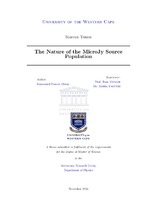| dc.description.abstract | The study of the faint radio universe and of its properties has recently become a very active field of research not only because of the much improved capabilities of the SKA pathfinders but also because of the need to better plan for SKA surveys. These new facilities will map large areas of the sky to unprecedented depths and transform radio astronomy into the leading technique for investigating the complex processes which govern the formation and evolution of galaxies. This thesis combines multi-wavelength techniques, highly relevant to future deep radio surveys, to study the properties of faint radio sources. The nature of the faint radio sources is presented, over a large GMRT survey area of an area of 1.2 deg2 comprising 2800 sources. Utilising multi-wavelength data we have matched 85% of the radio population to Spitzer/IRAC and obtained a redshift estimate for 63%. The redshift associations are a combination of photometric and spectroscopic redshift estimates. This study investigates several multi-wavelength diagnostics used to identify AGN, using radio, infrared, optical and x-ray data . This analysis shows that various diagnostics (from the radio through the X-ray ones) select fairly different types of AGNs, with an evidence of a disagreement in the number of AGNs selected by each individual diagnostics. For the sources with redshift we use a classification scheme based on radio luminosity, x-ray emission, BOSS/SDSS spectroscopy, IRAC colors satisfying the Donley criterion, and MIPS 24ɥm radio-loud AGN criteria to separate them into AGNs and SFGs. On the basis of this classification, we find that at least 12.5% of the sources with redshifts are AGNs while the remaining 87.5% are adopted as SFGs. We explore the nature of the classified sources through the far-infrared radio correlation. We measure a median qIR value of 2:45± 0:01 for the SFGs and qIR value of 2:27 ± 0:05 for the AGNs. The decrease in the median value of qIR for the AGNs is a result of the additional AGN component to radio emission for the AGN-powered sources and find tentative evidence of an evolution of the qIR with redshift. | en_US |

